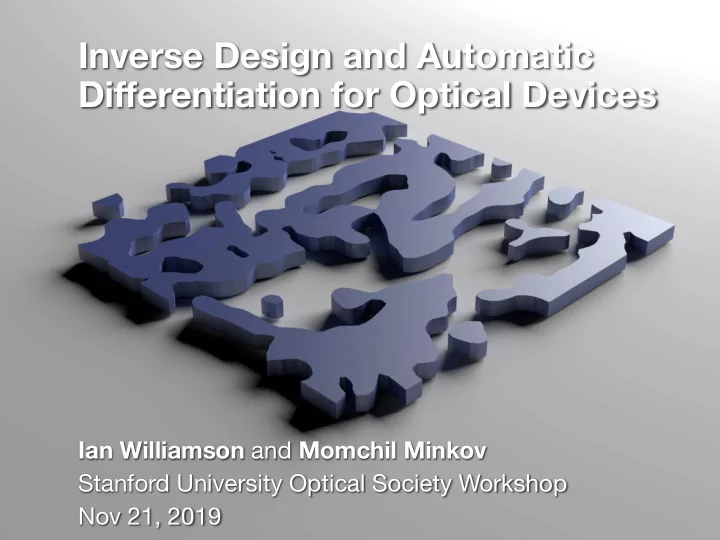

Inverse Design and Automatic Differentiation for Optical Devices Ian Williamson and Momchil Minkov Stanford University Optical Society Workshop Nov 21, 2019
https:// github.com / fancompute / workshop-invdesign 2
Workshop outline • Brief crash course on optical simulation • Theory of numerically solving Maxwell’s equations • Practical demonstration with our open source code • Inverse design theory / practical introduction • Adjoint gradient computation • Automatic differentiation • Connection to machine learning • Device parameterization techniques • Binarizing features • Optimization penalties 3
A history of optical simulation packages (from our group) MATLAB Wonseok Shin maxwellfdfd Yu (Jerry) Shi fdfd_suite Python Ian Williamson angler fdfdpy Tyler Hughes Momchil Minkov Ian Williamson ceviche gradient-enabled 4
A quick crash course in optical simulation 5
How do we simulate optical devices? ... we solve Maxwell’s equations! electric field magnetic field current source relative permittivity this represents our device! 6
Welcome to the optical device zoo Stern Group (Northwestern Univ) Witmer et al. Opt. Express 24, 5876-5885 (2016) Wang et al. Nat. Comm. 8, 2098 (2017) Kocaman et al. Nat. Pho. 5, 499–505 (2011) Soler Penades et al. Opt. Express 24, 22908-22916 (2016) 7
Constructing a set of equations to solve Some assumptions we make: • A two-dimensional domain (invariant along z -direction) • All fields are also invariant along z -direction • Electric-field polarized only along z -direction 8
Constructing a set of equations to solve 9
Where can these equations take us? Inverse-designed Interesting / useful Optical devices we optical devices can analytically model optical devices 10
The key idea behind finite differences ... • Very simple concept that can be scaled up to solve complex PDEs • Convergence to the exact solution at a rate proportional to h (depends on “stencil”) 11
Discretizing Maxwell’s equations continuous PDE discretized PDE Along just one dimension, this looks like... Along two dimensions, the representation is a bit more complex, but the same idea applies! 12
Discretizing Maxwell’s equations spatial representation discretized PDE flattened representation sparse linear problem: 13
The ceviche package (at a high level) 14
Notebook #01 15
Inverse design • Assume that we can “mold” the permittivity • Try to get the best possible structure for a particular desired functionality. Piggott, A. et al., Nature Photonics , 374–377 (2015) 16
Inverse design • We want the gradient of some objective function w.r.t. the permittivity at every point • Efficiently! Piggott, A. et al., Nature Photonics , 374–377 (2015) 17
Recommend
More recommend